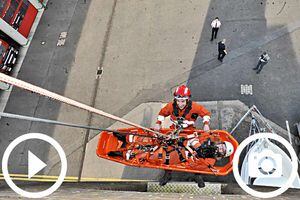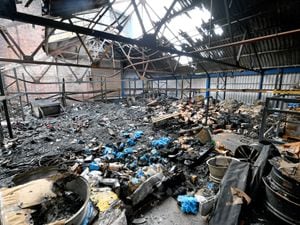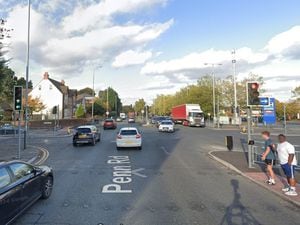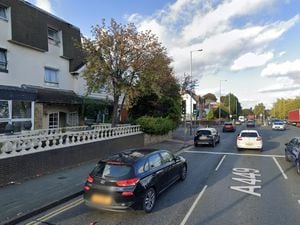Danger – all in a day's work for crack West Midlands Fire Service unit
[gallery] Their challenges have included winching a man to safety from the side of a skyscraper, crawling through collapsed buildings, cutting through steel girders at 2,500 degrees of heat and rescuing a builder covered up to his neck in soil at the bottom of an 18ft-trench. And they also put out fires.

The West Midlands Fire Service Technical Rescue Unit (TRU) is a specialist team of firefighters deployed on the toughest, high-risk call-outs where disaster can lurk around every corner.
Based at Bickenhill Fire Station near to Birmingham's NEC, the four eight-man crews' act as support to regular fire crews when their specialised skills and equipment are required.
And the Black Country is all set to have its own unit, with a 32-man team set to be stationed in Wednesbury from the start of next month.
The units are charged with tackling the most complex jobs, including sea and river rescues, flooding assistance, rope, confined space and altitude rescue and casualty extrication.
One dramatic scene involved the TRU assisting other emergency services with the rescue of a construction worker who had become trapped under two tons of soil when a trench he was working on collapsed.
When the crew arrived at the scene in Barclay Road in Bearwood, Birmingham, the man was covered up to his neck 18ft down in the trench.
Crew Commander Rob Norman of Blue Watch said: "One side of the trenches had caved in leaving one of the workers trapped in the bottom of the trench," said Mr Norman. Only his head was visible.
"We worked with ambulance crews and other fire crews, using specialist stretcher equipment and a hoist to extricate him from the hole.
"It was a long and complicated job because there was a danger the rest of the trench could collapse at any minute."
The man was rescued from the trench after two-and-a-half hours and was treated for chest injuries at Queen Elizabeth Hospital, Birmingham.
"This could have been very nasty indeed but the combined efforts of the emergency services managed to get him out," added Mr Norman.
The work of the TRU is vast and wide-ranging.
On one occasion the team was called out to a house in the West Midlands last year to assist an obese woman who was trapped in her bedroom and was struggling to breathe .
"The woman was more than 30 stone and needed to leave the house for urgent hospital treatment.
"She was having breathing difficulties but had become housebound and because of her size paramedics were unable to get her to an ambulance. She was basically trapped in an upstairs room.
"The Green Watch crew was called out by paramedics and quickly devised the quickest way of conveying her safely out of the property."
"This involved cutting away the frame from a first floor bedroom window and winching the woman down to ground level using ropes and a stretcher. Our guys were able to help her into the ambulance where the paramedics stabilised her and took her to hospital where she could get the treatment she needed," added Mr Norman.
Mr Norman said a prime example of the various strands of the emergency services working together happened in Handsworth Wood, Birmingham in early February.
A crew from the TRU was called out when a large tree blew over in gale force winds and crushed a car, trapping three passengers, two of whom were seriously injured.
"The first regular crew on the scene saw that specialist equipment was required for the rescue operation," said Mr Norman.
"Because their commander was familiar with what we can offer he contacted us straight away.
"It was a delicate and intensive operation because the tree had completely crushed the roof of the vehicle and three people were trapped inside unable to move." Mr Norman said the task was made more difficult by the need to move the tree without shifting the position of the car.
"Paramedics were tending to the casualties inside the car while we were using chainsaws to cut away the tree. The tree's branches were intertwined with car's roof, and any sudden movement could easily have caused further injury to the passengers.
After the tree was safely removed the TRU set about stripping away the cars collapsed roof using hydraulic cutting equipment before removing the passengers to safety.
A woman in her seventies required hospital treatment after suffering a chest injury and a broken leg as a result of initial accident, while another woman suffered minor neck injuries.
"We had to work quickly and with great care but thankfully we were able to get the passengers out safely. There is no doubt the situation could have been a lot worse." Equipped with specialist 'national resistance' equipment, TRUs were originally developed throughout the UK as part of the government's anti-terrorism measures which came into force after the 9/11 attacks in the USA and London bombings in July 2005.
But with terrorist attacks not happening on a daily basis, the crews' materials and transportation were adapted for use in the West Midlands and beyond, as Crew Commander Rob Norman of Blue Watch explained.
"We are trained and kitted out to deal with large scale operations," he said.
"But the principal remains the same whatever situation we are deployed to deal with, be it a traffic collision involving heavy transportation or an animal rescue.
"Our task is to work in tandem with fire crews to ensure the safety of the individuals involved and make sure the area is secure."
Their fleet of modified vehicles – including a Four-man New Dimension Prime Mover, two fast-response Mercedes Sprinter Vans and a Bobcat utility vehicle – feature a vast array of high-tech gear the A-Team would be proud of. A lot of the challenges we face require specialist equipment that standard fire crews may not have access to," added Mr Norman.
"If a job requires us to cut through concrete or steel we are equipped to deal with it, and the same applies to heavy lifting or rope rescues."
Since April 2013 the units have added a more conventional task to their remit – tending to fires.
"Initially we were firefighters who dealt with almost every incident except fires," said Mr Norman. "But that changed last year and we can also be called out as first response to jobs the average person would more commonly associate with the fire service."
The unit has recently taken on 32 new recruits in preparation for the official opening of the Black Country's first Technical Rescue Unit at Wednesbury Fire Station on April 1.
The technicians – all of whom are trained firefighters – have been through a rigorous training process which can last up to 18 months. The regime involves specialist training at the Fire Service College in Moreton-in-Marsh and the West Midlands Fire Service Academy in Smethwick, as well as on site instruction and one-on-one work with a training officer.
It also features a gruelling three-day practical training camp in Wales where potential recruits are tested on their ability to react to high impact events under conditions including sleep deprivation and sensory deprivation.
A crew from the TRU was called to perform a training exercise when Birmingham's iconic landmark The Cube was under construction in 2010.
With builders on the site working at heights of up to 100ft, bosses at the construction firm wanted to put an emergency strategy in place in case anyone became stranded or got injured. Mr Norman said: "They needed a plan for dealing with an emergency situation at height. They were asking the questions 'what do we do if someone gets hurt whilst working 100ft in the air?', 'how do we get someone up there to deal with an incident?' Showing people how to deal with potentially difficult situations is part of our job, so we went over there and showed them how to do a rescue."
Two crew members put up a rope controlled device featuring a small Slix stretcher at the building's summit.
Then one acted as casualty in the stretcher whilst the other, suspended underneath, played the role of attendant and guided the contraption down to safety. "We work closely with the Ambulance service so in a real life situation the barrow boy may be a paramedic who could tend to the needs of the casualty on the way down," said Mr Norman. Steve Mann, from Sheldon, recently completed the process and has been based at Wednesbury Fire Station since July. "The training is hard and you have to take on a lot of extra skills," he said. "Often you have to make decisions quickly and under pressure." Unit members work on 96-hour shift patterns, meaning they can be called out to a job anywhere in the country at a minutes notice during the four-day period – even when they are not at work.
Station Commander Pete Drummond joined the Technical Rescue Unit seven years ago having spent 18 years with the fire service.
"When the unit started out it was a bit of a leap of faith," said the 42-year-old.
"No one could be sure whether it was something that would last, but our role has developed over the years and we have become more integrated into the fire service.
"We recruit from within the service and we actively look to target specific types of people. This is certainly not for everyone. It can be intense and we expect our people to retain a lot of information, demonstrate extreme practical ability as well as being versatile and open-minded about how they react to situations. We ask a lot of our guys and they are a highly motivated group."





